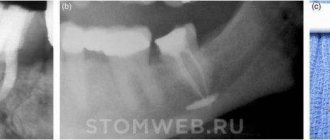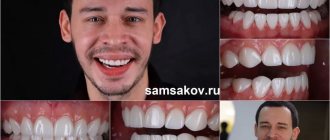Teeth have a special coating called enamel. It performs a protective function, protecting soft parts from the penetration of bacteria into them, and also prevents the possibility of mechanical damage. With improper dental care, a process called demineralization develops. It represents a decrease in the amount of essential salts and minerals in the enamel, which ultimately leads to disruption of its structure. To prevent the occurrence of negative consequences from this process, dentistry has a special procedure - remineralization of teeth. With its help, it is possible to restore thinned enamel, which is successfully implemented only in the initial stages of the development of pathology.
Remineralization of teeth - what is this process?
The porosity of the enamel allows the free passage of acids into the enamel layer, which leads to the leaching of useful minerals. This is a normal process that occurs continuously in a healthy body. Minerals washed out by acids are replenished with new elements, which ensures the maintenance of the optimal composition of the enamel.
If the acid-base balance is disturbed, then the development of the demineralization process is observed. The amount of minerals washed out by acids is actively decreasing, and their composition is not replenished. The procedure for remineralization of teeth is carried out to restore the quality of tooth enamel, that is, the missing amount of mineral substances is replenished.
What to do with a thin protective shell
In case of damage or genetic predisposition, there is no need to be upset. We will have to strengthen control and care of the oral cavity in order to prevent the development of pathological processes and long-term treatment, but there is nothing terrible about it. Follow a few basic principles that will help keep your smile beautiful and your teeth healthy:
- stop eating solid foods;
- visit the dentist at least once every six months;
- carry out professional fluoridation;
- use remineralizing agents twice a day as prescribed by your doctor;
- stick to a diet, eat more vegetables, fruits and healthy foods.
To prolong the beauty of a smile, it is enough to increase attention and care. This will not take much time, but will prevent further tooth thinning and damage.
Causes of demineralization
Acids entering the oral cavity contribute to the leaching of beneficial minerals, which leads to the development of the demineralization process. However, after eating food in a healthy body, their quantity is restored. If malfunctions occur in the human body, for example, plaque forms on the teeth due to insufficient care, then the acidity balance is disturbed, which entails the development of pathology. The most common causes of the process of demineralization of tooth enamel include the following:
- Hygiene is not maintained - teeth brushing should be done 2 times a day, and its duration should be at least 2 minutes. After eating food, it is recommended to rinse the mouth with special preparations or plain water.
- Nutritional imbalance - if the diet contains a lot of carbohydrates and there is an insufficient supply of minerals.
- Consuming a large number of acid-containing foods, which include not only citrus fruits, but also various carbonated drinks.
- Metabolic disorders or hormonal imbalances in the body that occur against the background of various factors: pregnancy, stress, adolescence, etc.
- Bad habits - in particular, smoking contributes to the active development of the demineralization process.
- Bleaching of enamel, which ultimately can also lead to the leaching of mineral substances and, as a result, cause the development of pathology. This procedure must be carried out by an experienced professional, and after it is performed, the patient must follow strict hygiene rules.
- Wearing dentures and braces - failure to follow the rules of care leads to damage to the enamel.
In order to detect dental diseases in a timely manner, you only need to regularly visit the dental office for preventive examinations.
Diagnosis of the disease
Diagnosis of suspected demineralization comes down to the following procedures:
- Inspection . The doctor cleans the teeth of plaque and dries them. The presence of white matte spots on the teeth indicates pathology.
- Enamel staining . The doctor stains the cleaned and dried teeth with blue dye. Unlike healthy areas, areas of demineralization are stained. Moreover, the brighter the shade, the more serious the damage to the enamel.
- Application of ultraviolet light . When teeth are illuminated with ultraviolet light, healthy areas glow blue, while damaged areas glow dark.
- Using a laser . The method is based on the fact that areas with different mineralization reflect laser waves of different lengths.
The remineralization process: how it is carried out
Remineralization allows you to restore the quality of enamel by filling it with important trace elements. In this case, hard tissues are strengthened. Due to all this, the sensitivity of teeth (to cold, hot) is ultimately reduced, and the likelihood of developing caries will be much lower.
A professional procedure is carried out by treating teeth with special preparations that contain the necessary mineral components: usually calcium, magnesium, phosphorus, fluorine. They are left on the teeth for several minutes until the enamel is completely saturated. The technique includes the following steps:
- Teeth cleaning.
- Treat them with a 1% hydrogen peroxide solution, followed by drying.
- Applying tampons with a 10% solution of calcium gluconate, which are applied for 20 minutes and changed every 5 minutes.
- The final stage is an application of sodium fluoride for 5 minutes.
Important! Sometimes electrophoresis is used to speed up the remineralization procedure.
Treatment involves completing an appropriate course (15-20 sessions), since one procedure does not achieve the desired result. In order to avoid the recurrence of problems with the development of pathology in the future, you need to regularly visit the dentist and, if necessary, immediately restore the thinned layer of tooth enamel.
How to strengthen tooth enamel
Fluoridation
Fluoridation is the most common and only proven effective way to strengthen enamel. It involves applying fluoride-containing compounds to the surface of the teeth.
Penetrating into tooth enamel, fluoride accelerates the absorption of calcium and phosphorus, strengthening and restoring the tooth surface.
It happens like this: fluorine molecules combine with hydroxyapatite, forming hydroxyfluorapatite, a mineral that is resistant to acids. Learn more about the benefits of fluoride
For home care and caries prevention, you can use fluoride toothpastes. The most effective are those containing sodium fluoride and amino fluorides. The higher the fluoride content, the stronger the remineralizing property of the paste and the protection against caries.
The fluoride concentration in toothpaste is measured in ppm or percentage. If the tube says that it contains 900 ppm fluoride, then a kilogram of paste will contain 900 mg of this element.
| Type of pasta | Purpose | Fluoride amount |
| Preventative | For daily use. | up to 1000 ppm |
| Medical | Intensive strengthening of enamel at the first signs of caries. The time of use is limited by the course prescribed by the doctor. | 1000-1500 ppm |
Toothpastes with fluoride
Toothpaste CURAPROX Enzycal 1450
ApaCare Remineralizing Toothpaste
Colgate Elmex Toothpaste Caries Protection
Elgidium toothpaste Protection against caries
Nanohydroxyapatite
Medical nanohydroxyapatite is no different in composition from natural one. Thanks to this, it is easily integrated into the crystal lattice of enamel and solves the following problems.
- Seals microcracks.
- Reduces tooth sensitivity.
- Eliminates caries at the white spot stage.
Toothpastes with hydroxyapatite
Biorepair Total Protection toothpaste 75 ml
miradent mirasensitive hap+ toothpaste for sensitive teeth
Vivax toothpaste. Remineralization.
Dentissimo Complete care toothpaste Complete care
Amorphous calcium phosphate
When in contact with saliva and hydroxyapatite, this element forms a special biofilm on the surface of the teeth, which:
- protects enamel from the harmful effects of acids;
- ensures the connection of bioavailable calcium with enamel, accelerating its remineralization.
Important! Since the active substance is obtained from cow's milk casein, this method of strengthening enamel is not suitable for people with allergies to milk protein.
Gels and toothpastes with amorphous calcium phosphate
Tooth gel GC MI Paste Plus Mint
Tooth gel GC Tooth Mousse Strawberry
Toothpaste Apagard Premio 100 ml
Theobromine
This is the youngest, most innovative way to strengthen enamel using cocoa bean extract. Theobromine stimulates the formation of its own hydroxyapatite crystals in the enamel. Theobromine pastes are produced by Theodent brand.
The remedies listed above can be used at home to prevent and treat minor oral problems.
Pros and cons of performing the procedure
If you resort to teeth remineralization in a timely manner, the effect will be maximum. Among the advantages of the procedure:
- Absolute harmlessness, safety and painlessness.
- Quick and reliable restoration of the integrity of the tooth coating (enamel).
- Prevention of the development of oral diseases.
Remotherapy is prescribed not only to adults, but also to children. After all, the condition of the baby teeth determines what the permanent teeth will be like.
There are practically no disadvantages of remineralization. The choice of means depends on the individual characteristics of the body. The effectiveness of the procedure is associated not only with the drugs chosen for its implementation, but also with the correctness of the preparatory work (teeth cleaning and sanitation).
Effect after remotherapy
Remotherapy is an absolutely painless procedure. No anesthesia is required. Remineralization is safe and can be carried out during pregnancy, prescribed to children to strengthen the enamel of baby teeth and as the main means of caries prevention. Remotherapy can reduce tooth sensitivity, improve the structure of the enamel, making it denser, stronger and more resistant to acids and other aggressive substances.
In combination with other methods of prevention, such as fissure sealing, fluoridation and ozone therapy, remotherapy can reduce the risk of developing a carious process to zero. Often, along with dental treatment, gum treatment and diet correction with medications and vitamins are required. In addition, remotherapy is necessarily carried out after teeth whitening and orthodontic treatment procedures. Remotherapy is also necessary for pregnant women and adolescents.
Indications and contraindications for
Indications for remineralization are the following factors:
- Identifying signs of demineralization.
- Increased sensitivity of teeth to food, hot and cold.
- Plaque on the teeth.
- Sensitivity appears after teeth whitening or tartar removal.
Remineralization is a virtually harmless and safe procedure that has no contraindications. It is prohibited in one case, when the patient has an individual intolerance to the drugs used for therapy.
To keep your teeth healthy, it is important not only to maintain oral hygiene, but also to regularly visit the dental office. This will make it possible to identify diseases in the early stages and prevent their development using simple, safe, reliable and inexpensive procedures.
Focal demineralization of tooth enamel, photo
Above we described what focal demineralization of teeth looks like. Photos of patients with this pathology will be presented below. At the initial stage, focal demineralization can affect one or a small number of teeth; it is weakly expressed and often does not attract the patient’s attention at all.
Focal demineralization in adults is characterized by the extensiveness of the process - it is not uncommon that at the initial stage an entire row of teeth can be affected.
Demineralization of teeth, the photo of which is on the left, becomes more and more pronounced in the absence of treatment - the spots change their color from white to light, and then dark brown. Subsequently, focal demineralization ends with the formation of carious cavities.
Prevention
To prevent demineralization and after remineralization, careful oral hygiene is important: brushing teeth, rinsing with pharmaceutical rinses, using dental floss, a balanced diet, limiting coffee and sweet foods, avoiding smoking. In any case, visiting the dentist 2 times a year is simply necessary.
Despite all the effectiveness of remineralization, this method of tooth restoration is used at the initial stage of demineralization (when white spots appear). If the destruction of tooth enamel has acquired an advanced form, then the patient is unlikely to be able to avoid a drill or prosthetics. Take care of your teeth!
Sources used:
- Prevention of caries in the pits and fissures of teeth / T.V. Popruzhenko. - M.: MEDpress-inform, 2010.
- Prevention of inflammatory periodontal diseases. Textbook / A.I. Abdurakhmanov et al. - M.: GEOTAR-Media, 2015.
- Professional prevention in dental practice / Jean-François Roulet, Stefan Zimmer. - M.: MEDpress-inform, 2010.
- Fejerskov, O., Nyvad, Bente, & Kidd, Edwina A. M. (2015). Dental caries: The disease and its clinical management (Third ed.)
- St. Petersburg State Pediatric Medical University
Is it possible to completely restore enamel on your own?
Contrary to the fact that many want to see a positive answer in this section, there will not be one. If the coating began to deteriorate, then there were contributing factors, which do not always depend on whether the person cracked nuts with his teeth or not. You can only partially slow down this process before you can visit the dentist’s office and take drastic measures.
For protection, doctors offer the thinnest veneers. They are not felt in the mouth, do not bring the slightest discomfort, but at the same time, ceramics prevent microorganisms from reaching the protective shell and penetrating deep into the crown. In addition, the doctor can coat the dental plates with a fluoridating or remineralizing composition, which will prevent destruction for a long time. Therefore, to the question: how and whether it is possible to restore enamel on teeth at all, the answer will only be denial.









